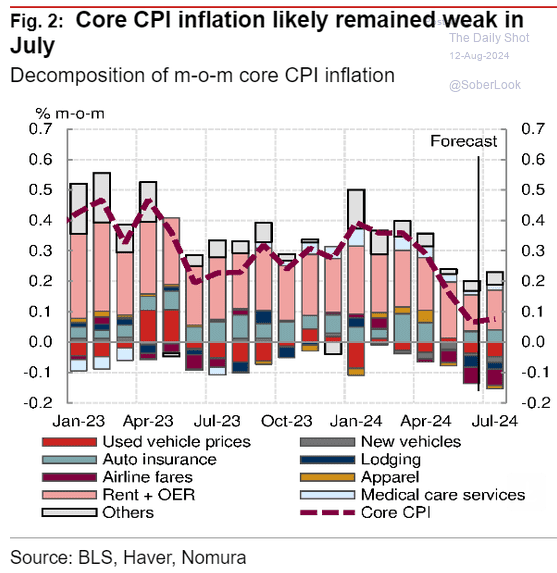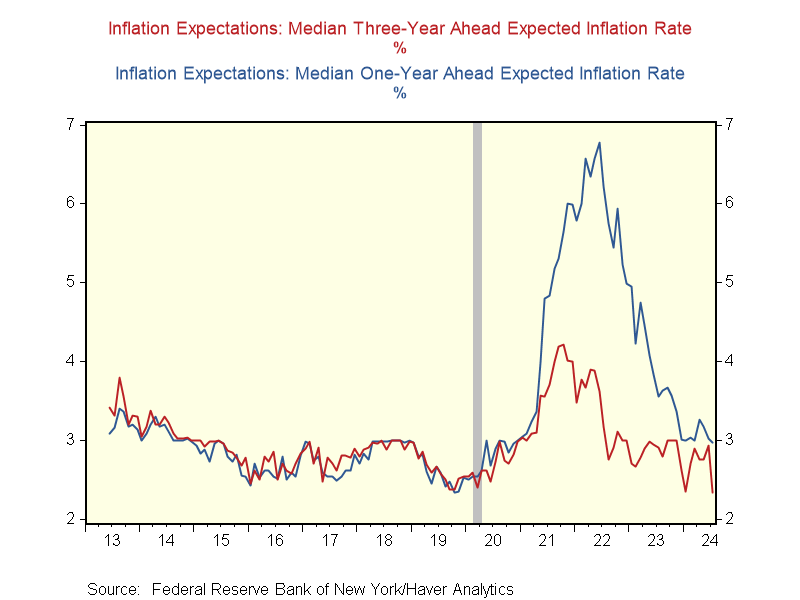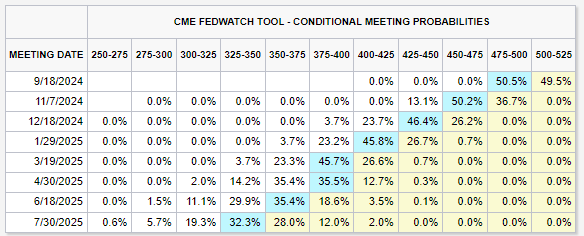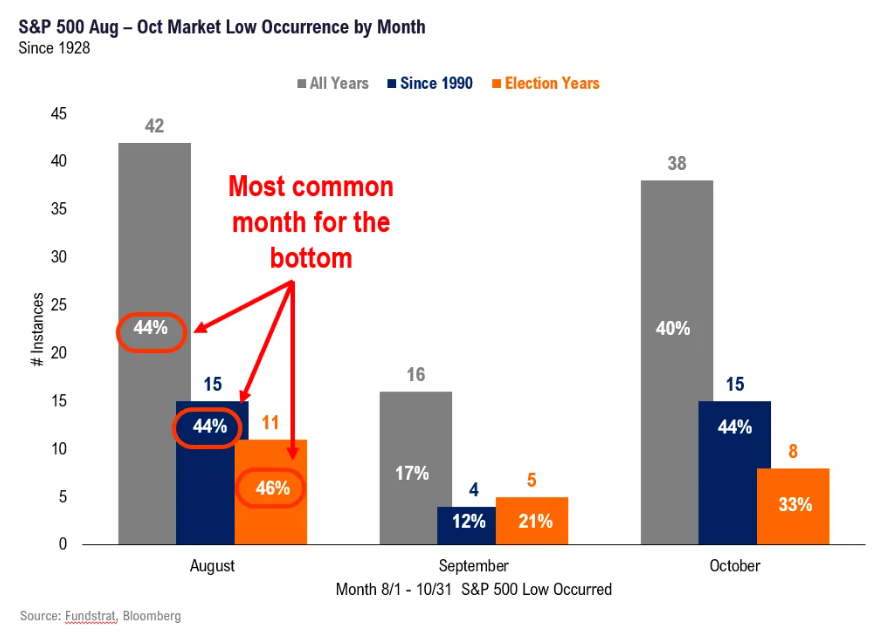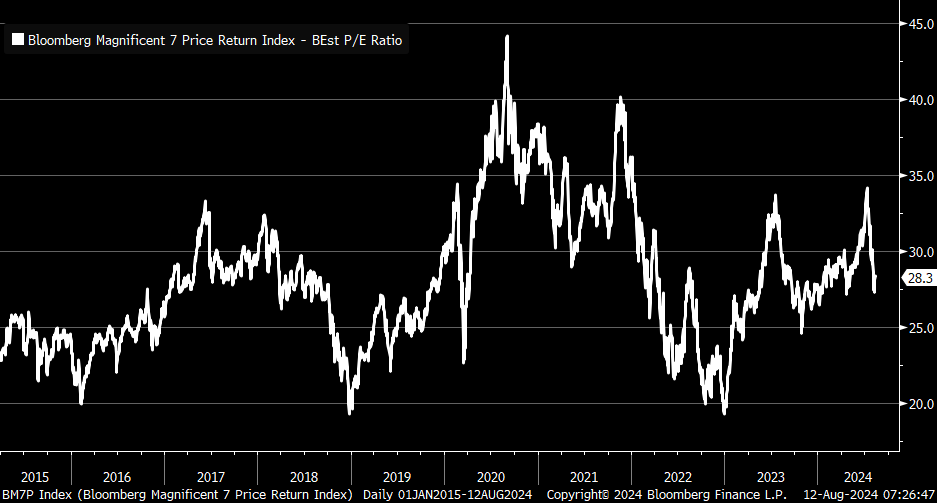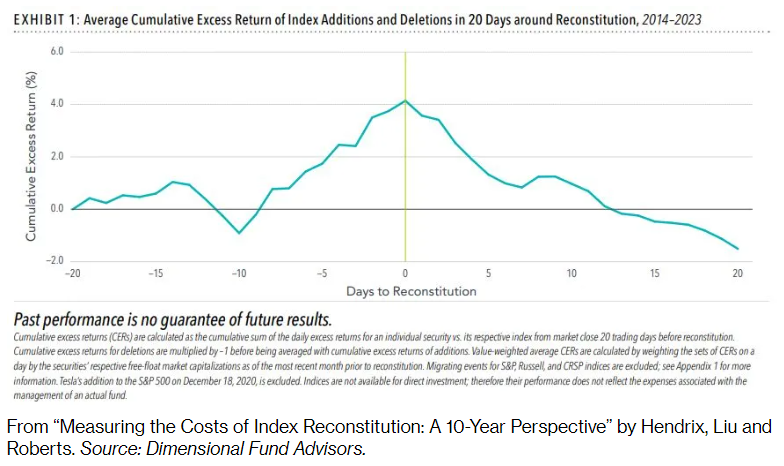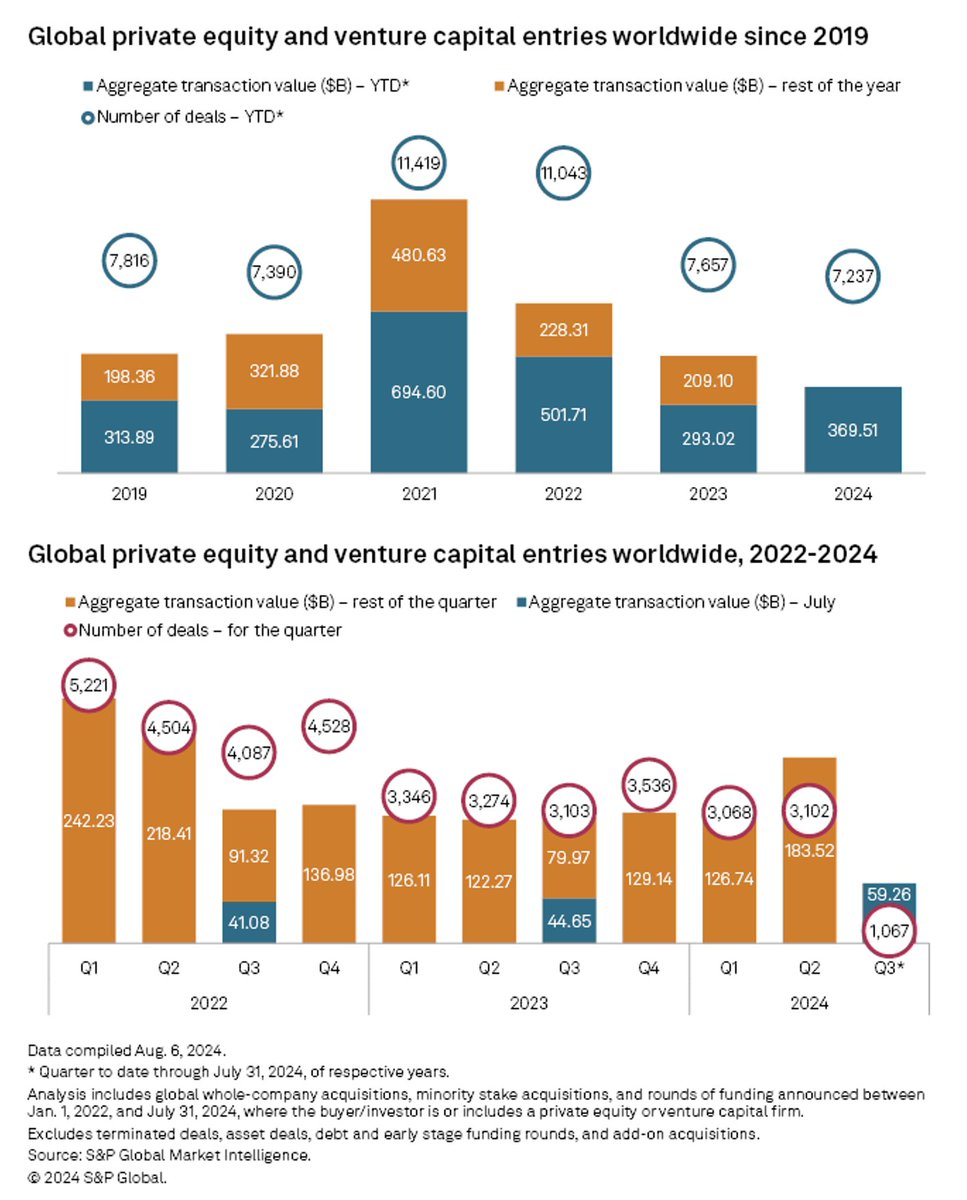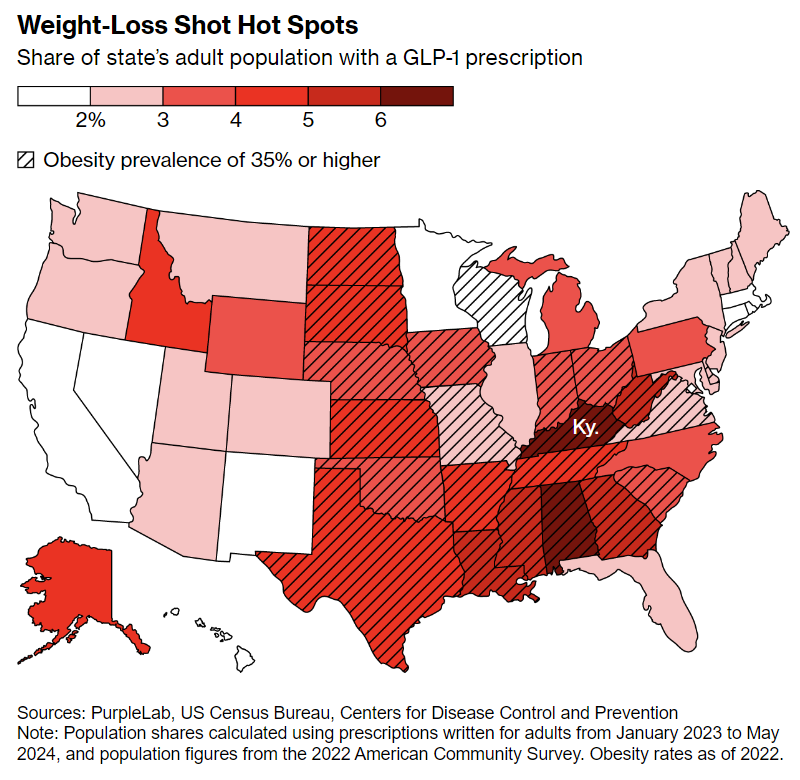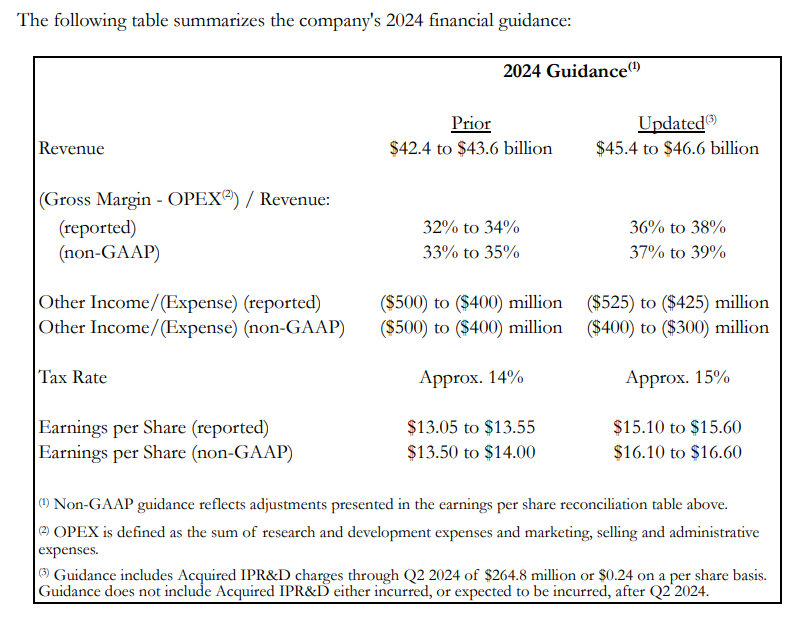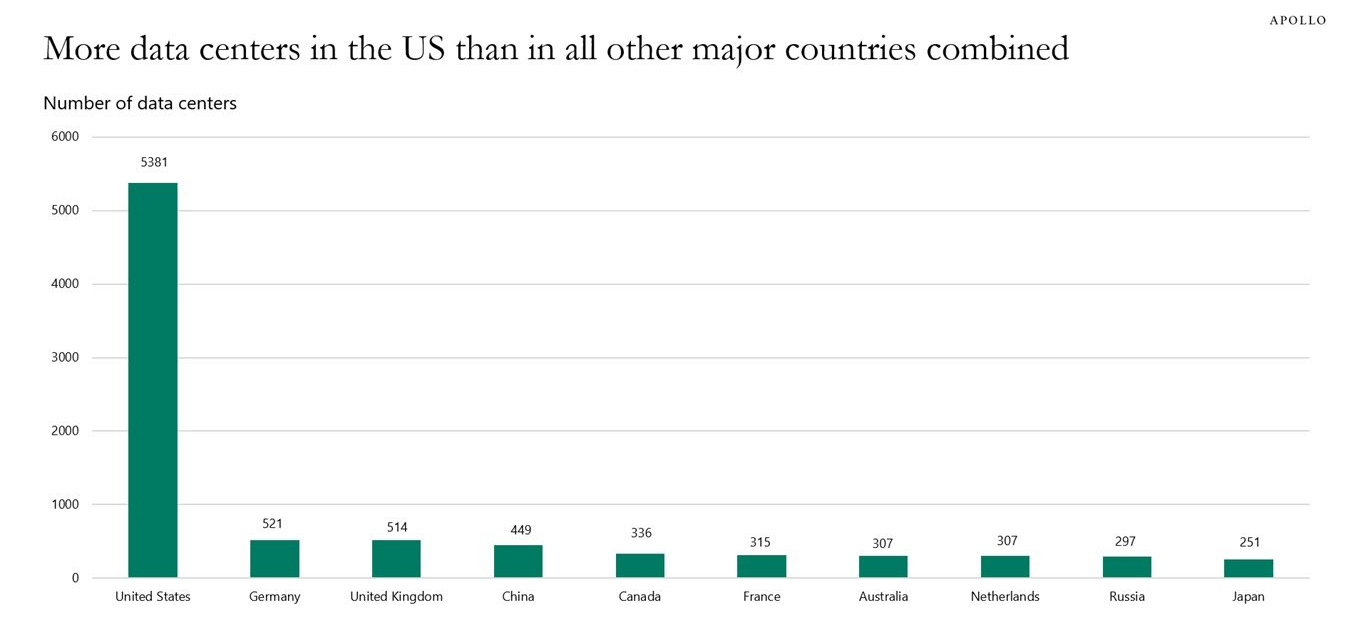
Weekly Research Briefing: Back to Class

Many U.S. school classrooms begin to fill up again this week. Another year of apples on the teacher’s desk, but this year those apples are the plug-in kind, and not red or green. The best educators and parents have finally figured out that school campuses should be off limits to instant messaging, social media and daily sports betting. Why did that take so long?
Last week the S&P 500 had the smallest weekly drop in over six years. Yes, you read that right. Down 2.4 points. If you added to your positions last week, great. If you sold, then you would have had more fun and made more money sitting on the couch, enjoying the Olympics with Snoop Dog. In a two-week window, the VIX moved from 20 to 60 to 20 all while de-risking both leveraged professional and unleveraged novice investors. The public markets can be cruel.
With the market now in a "good economic news is good for the markets" mood, last week's weekly jobless claims were a three-point basket for stock prices. This week we will look for equally good news out of Thursday's retail sales figures while also awaiting low inflation readings out of the early week PPI and CPI series. And some good datapoints out of the WalMart and Home Depot earnings releases.
Enjoy the first drop off or bus ride of the year. And don't forget that picture. Have a great week.
This week's inflation readings are going to again be among the lowest of the cycle..
With the monthly prints arriving with a 0.1% or 0.2% handle, how long will the hawks on the Federal Reserve be able to justify a Fed Funds rate over 5%?
The N.Y. Fed survey of inflation expectations fell sharply on Monday...
@RenMacLLC: New York Fed Survey of Consumer Expectations: "Median three-year-ahead inflation expectations declined sharply by 0.66% to 2.3%, hitting a series low since the survey’s inception in June 2013." Households will resist higher prices.
Beans below $10/bushel and Corn less than $4 is a gift for all bakers as a basket of grain prices falls to 4-year lows..
But even with inflation moving to 2%, there remain some hawks at the controls...
@NickTimiraos: Fed governor Miki Bowman, who is among the most hawkish on the FOMC: "I am not confident that inflation will decline in the same way as in the second half of last year."
She keeps the door open to a rate cut: "Should the incoming data continue to show that inflation is moving sustainably toward our 2% goal, it will become appropriate to gradually lower the federal funds rate to prevent monetary policy from becoming overly restrictive on economic activity and employment."
"But we need to be patient and avoid undermining continued progress on lowering inflation by overreacting to any single data point."
How can you not absolutely love this economic piece from last week. Well done Claudia...
The US is not in a recession, despite the indicator bearing my name saying that it is. The Sahm rule, which was triggered with Friday’s weaker-than-expected jobs report, joins a long list of economic tools skewed by the unusual disruptions of the past four and a half years.
That said — and I say this with a mixture of humility and concern — the Sahm rule is still relevant. The risk of a recession is elevated, strengthening the case for the US Federal Reserve to cut interest rates.
The National Bureau of Economic Research defines a recession as a “significant decline in economic activity that is spread across the economy and that lasts more than a few months.” The NBER makes its official determination several months after assessing a range of economic data. Right now, most of the data that the NBER considers look solid. For example, real consumer spending rose 2.6% at an annual rate in the second quarter, and monthly payroll gains averaged 170,000 in the past three months. A notable exception was employment as measured by the household survey, which is basically flat this year.
Still, while the economy is growing less quickly, it is growing. There is no recession, at least not yet.
There is now a 50/50 chance of a +0.50% cut in September...
Gone are last Monday's calls for an immediate 50 basis point rate at an emergency Fed meeting. But the market is still watching the September meeting closely for a cut.
Corporations continue to discuss a Fed cut on their calls and interviews...
@TheTranscript_: Hoping for rate cuts:
$ROK CEO: "...waiting for a potential reduction in interest rates.."
$FICO CEO: "We would hope to see some rate cuts.."
$JPM CEO: "I do expect they'll probably cut soon.."
$BAC CEO: "..it's time for them to start to...become a little more accommodative.."
A perfectly made point...
"History would suggest short-term fluctuations mean absolutely nothing...the volatility is not going to really impact the consumer in the next short period of time. But if you see it for several months, then I would expect us to see some slowdown in consumer spending...I think that consumer is used to seeing some volatility, and they have some probably built-in gains that they never thought they would have, right...honestly, I'm not looking at a current potential recession or tough market as any basis to slow down." - Simon Property Group CEO David E. Simon
My favorite consumer economic indicator showed no signs of a recession during July...
Costco Wholesale Corporation reports July Total SSS +7.2% y/y (ex-gas and FX) v +6.9% prior;
US SSS +6.3% (ex-gas and FX) v +6.3% prior
- July E-commerce SSS +20.2% (ex-gas and FX)
- July Net Sales $19.3B +7.1% y/y; July YTD Net sales $229.8, +7.1% y/y
TradeTheNews
And the Atlanta Fed's GDPNow is pointing to a +3% figure for the Q3...
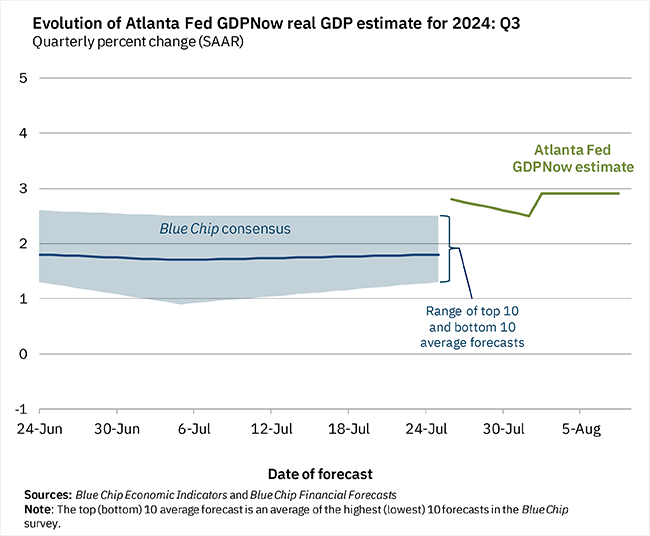 @AtlantaFed
@AtlantaFedWhen a cloud based lending platform tells you that credit quality is improving, you put a mark in the positive column...
Demand for consumer lending activity may be slowing, but what the economy doesn't need is a pickup in consumer credit problems.
"We are seeing credit default trends finally turn a corner, having peaked in aggregate sometime earlier this year, and now inflecting back down towards prior lower levels. This dynamic is reflected in our declining Upstart Macro Index, which has now unambiguously fallen for three consecutive months and has reached its lowest level since January of 2023. This downward-traveling UMI is now a consistent pattern across all borrower segments that we can observe." - Upstart CFO Sanjay Datta
Note to future investing self: BUY top decile VIX readings, do not SELL...
@dailychartbook: “Welcome to the blue zone: the top decile VIX readings, often associated strong forward equity returns. Expect more volatility though.” @Todd_Sohn
Smart investors like Ari Wald at Oppenheimer tend to do very well buying oversold conditions in long term uptrends...
The August doldrums also typically set the low prices for the end of summer months as kids return to school and adults to work...
With the broadening out of the market, the Mag-7 has now retreated to only 28x forward earnings...
@KevRGordon: Magnificent 7's forward P/E was at 34.1 in mid-July and has now corrected to 28.3
Most of the names in the Mag-7 are still expected to grow faster than 20%...
@MikeZaccardi: The Mag 7 median forward 2-year EPS CAGR points to an acceleration in growth
Index funds will need to find a better way to add and delete names or else continue to get their pockets picked...
Wall Street has long thought that one of passive investing’s biggest flaws was fading away. Not so fast, says Dimensional Fund Advisors.
The so-called index effect, where stocks joining a major benchmark display abnormal returns in the days leading up to their addition before reversing after, is alive and well, according to the pioneering quant firm. As a result, investors with trillions of dollars in passive products are leaving “returns on the table,” Dimensional argues in a new study.
It’s all because index funds tend to doggedly track their gauges with rigid, predictable trades. The effect means they aren’t operating efficiently.
“Index funds are systematically buying at temporarily high prices when they’re adding and selling at temporarily low prices, which is the opposite of what you’re supposed to do as an investor,” said Joel Schneider, deputy head of portfolio management at Dimensional. “They’re doing the exact opposite because of their own mechanics.”
Private equity firms are putting money to work as S&P Global shows below...
@dailychartbook: "Global private equity and venture capital deal value is on the rise this year, even in the face of investor concerns about interest rates and a possible US recession." @SPGlobal
And a top law firm is going to write some summer bonus checks just to keep the deal teams working...
U.S. law firm Milbank is doling out seniority-based bonuses up to $25,000 to its associates and counsel globally, in a move that could drive competitors to do the same.
Bonuses for first-year associates will start at $6,000 and increase by class year, according to an internal firm memo on Thursday that was viewed by Reuters. The so-called special bonuses will be paid by Sept. 30.
"We know that the first seven months of the year have been extremely busy for the firm," Milbank chairman Scott Edelman said in the memo. "And based on the pipeline of work, we expect that the pace will continue through the summer and the rest of the year."...
The M&A market cooled off over the past few years. However, demand for legal work on corporate transactions is rising after nearly three years of sluggish results, according to a Thomson Reuters Institute report released earlier this week on law firms' performance in the second quarter of 2024.
Speaking of deals, here is a Canadian bank making a big deposit into a U.S. regional bank...
Bank of Nova Scotia has agreed to invest $2.8 billion in KeyCorp, positioning itself for new commercial opportunities and strengthening its foothold in the U.S. market.
The move by the Canadian financial institution targets one of its key markets, with the investment in KeyCorp significantly boosting its capital deployment in the U.S.
“This transaction provides attractive near-term returns to our shareholders and creates future optionality for Scotiabank in the North American corridor,” Scotiabank Chief Executive Scott Thomson said Monday.
KeyCorp, which is based out of Cleveland, Ohio, operates about 1,000 branches across 15 states and has $187 billion in assets. The company offers commercial and retail banking, as well as investment advice and services.
While Scotiabank doesn’t have a retail presence in the U.S., it does operate in the country through its financial services arms, Global Banking and Markets, Global Business Payments and Wealth Management.
Also, a Canadian utility selling off its growth energy assets into the private infrastructure market...
Algonquin Power & Utilities has agreed to sell its renewable energy business for $2.5 billion, a year after putting the segment up for sale.
The Canadian renewable energy and regulated utility company said Friday that it has agreed to sell the business, excluding its hydro assets, to a wholly owned subsidiary of LS Power, an investment and operating company that focuses on energy production, transmission and infrastructure.
And Russell 2000 small cap component PetIQ goes private at a 50% premium...
Private equity firm Bansk Group will acquire pet health company PetIQ, opens new tab for about $1.5 billion in cash, the companies said on Wednesday.
The deal gives the consumer health-focused private equity firm access to PetIQ's pet health products, including over-the-counter medications, diagnostic tests and grooming services.
As part of the deal, Bansk Group will pay $31 for each share of PetIQ held, representing a premium of 51% to the stock's last close.
Also, a multi-billion real estate deal between two giants...
Apartment giant Equity Residential said it has agreed to purchase 11 apartment complexes with more than 3,500 units for $964 million, the latest big investor bet that rents and values are poised for a rebound.
Its acquisition of the garden apartments and other types of rental units in the Atlanta, Denver and Dallas/Fort Worth regions marks the biggest U.S. multifamily purchase by any public real estate investment trust in the past seven years.
The seller is the investment firm Blackstone, which otherwise has been a big buyer of apartments this year. In June, Blackstone completed its purchase of Apartment Income REIT, an owner of upscale apartment buildings, for about $10 billion. It is selling these properties to Equity Residential in part to return cash to investors.
Would U.S. food companies be better off in private hands? Of course they would...
Ask any CEO what percent of his shareholders actually care about the long-term? The most aggressive analysts at investor conferences or on the conference calls are focused on what will be the next catalyst that can help them to outperform in the short term. That is because most hedge funds and many mutual funds get paid on their 12-month performance. And when management teams take their eye off the horizon and stare down at the balance beam, guess what happens?
That is one question raised by the bid for Kellanova from family-held Mars Inc. As with other struggling sectors such as department stores, there is a case to be made that packaged food sellers would benefit from ownership by patient capital, away from the quarterly spotlight on public companies.
Investors in packaged food seem unable to make up their minds about what they want from companies. A year or two ago they were worried that sales growth was coming solely from higher prices. Now that volumes have rebounded on the back of increased promotions, they are concerned about falling prices. Stocks have been making huge moves up or down every quarter based on minute fluctuations in sales momentum...
Would pairing Kellanova brands such as Pringles and Eggo waffles with Mars’s Snickers and M&Ms really deliver far better synergies than keeping them with Frosted Flakes and Rice Krispies? Probably not, especially after all the transition costs of demerging and then merging again are taken into account.
Of course, if the deal happens we may never know what synergies were realized, because Mars will be under no obligation to tell us. And that could be the point. It may simply be that these brands can breathe and ultimately grow better if taken out of public view for a while.
GLP drugs have taken over Bowling Green, Kentucky. Your town is next...
Bowling Green is perhaps best known as the home of the General Motors Co. assembly plant where Chevrolet Corvettes are manufactured and the birthplace of the mid-20th century food sage Duncan Hines. A decade ago there were still farms on the outskirts of town. Kentucky’s third-largest city, with 74,000 residents, Bowling Green today is crisscrossed with strip malls and highways. While there’s some bus service and a smattering of bike lanes, most people get around by car, and rush-hour traffic can be heavy. Residents say there’s not much to do besides eat, and there are plenty of options for that: The official web page for the Bowling Green Area Convention and Visitors Bureau boasts that, “according to local lore,” the city has more restaurants per capita than any other in the US.
Bowling Green can now boast of something else: It’s Ozempictown, USA. Kentucky has the highest concentration of people with weight-loss drug prescriptions in the country, according to data from PurpleLab Inc., which tracks most scripts covered by insurance companies. In Bowling Green and its surrounding area, at least 4% of residents have received prescriptions to take one of these medications in the past year or so—putting it ahead of other major population centers in the state. (For comparison, prescription rates in Brooklyn, New York, and the Miami area are closer to 1%.) And these are conservative estimates. PurpleLab doesn’t count people who are paying out of pocket or using copycat versions of the drugs often sold at smaller pharmacies, online telehealth operations and medical spas, which are significant and growing parts of the weight-loss drug economy, particularly in Bowling Green. The drugs’ proliferation in the city is even more impressive when you consider that Kentucky’s state Medicaid program doesn’t cover them.
Spend a few days talking to people in Bowling Green, and it seems like everyone has friends on a drug like Ozempic or is taking one themselves. The waiting room is filled at Doctors Diet Program, a weight-loss clinic where shots are available, and the place is so busy that nurses haven’t bothered to close the door of a room where they’re weighing patients. At local pharmacies, the phones are constantly ringing with callers asking if the drugs are in stock. “Ozempic and Wegovy, that’s all I hear,” says Brianna Tooley, a pharmacy technician at a Walgreens in town. Denmark-based Novo Nordisk A/S, the company behind Ozempic, has at least a half-dozen sales reps in Bowling Green and regularly sponsors events with local pharmacists.
Large-cap growth stock investors are getting fat on the size of the quarterly weigh-ins that Eli Lilly continues to register...
"Revenue grew 36% in Q2 with our new products growing nearly $3.5 billion compared to the same period last year. U.S. demand for Mounjaro and Zepbound is strong and growing as access and supply continue to expand. While weekly prescription volume was volatile in the first half of the year due to challenges fulfilling high demand, our progress on supply gives us confidence in our outlook." - Eli Lilly and Company CEO Dave Ricks
Your AI data point of the week...
"We have commitments from customers for more than 15 gigawatts of incremental load by the end of this decade, mostly driven by large load opportunities. To put this in perspective, AEP's system-wide peak load at the end of last year was 35 gigawatts. We continue to work with data center customers to meet their increased demand while ensuring contracts and new initiatives are fair and beneficial for all of our customers." - American Electric Power Interim CEO Benjamin Fowke
This was also surprising to me...
"Revenue grew 36% in Q2 with our new products growing nearly $3.5 billion compared to the same period last year. U.S. demand for Mounjaro and Zepbound is strong and growing as access and supply continue to expand. While weekly prescription volume was volatile in the first half of the year due to challenges fulfilling high demand, our progress on supply gives us confidence in our outlook." - Eli Lilly and Company CEO Dave Ricks
Once more I ask, "What took so long?"
"Our research shows that 80% of our customers prefer an assigned seat, and 86% of our potential customers prefer an assigned seat. Further, when a customer defects from Southwest to one of our competitors, our open seating policy is cited as the number one reason why." - Southwest Airlines CEO Robert E. Jordan
Learn more about the Hamilton Lane Strategies
DISCLOSURES
The author has current equity ownership in: Eli Lilly & Company, Costco Wholesale Corp. and Home Depot Inc.
The information presented here is for informational purposes only, and this document is not to be construed as an offer to sell, or the solicitation of an offer to buy, securities. Some investments are not suitable for all investors, and there can be no assurance that any investment strategy will be successful. The hyperlinks included in this message provide direct access to other Internet resources, including Web sites. While we believe this information to be from reliable sources, Hamilton Lane is not responsible for the accuracy or content of information contained in these sites. Although we make every effort to ensure these links are accurate, up to date and relevant, we cannot take responsibility for pages maintained by external providers. The views expressed by these external providers on their own Web pages or on external sites they link to are not necessarily those of Hamilton Lane.
